|
Topic: |
Rig Shots 8: Do Vacuum Cups damage
paint or panels? |
|
Author/Copyright: |
John Jovic |
The simple answer is yes, they can!
Damage from vacuum cups can be as extreme
as a shattered window, windscreen or dented panel. Often this kind
of damage is the result of poor judgment when fitting the cups or rig in
the first place as
no car panel, window or windscreen is designed to hold a large heavy
rig. Other times the rig may move or fall on the car because one or more
suction cups have lost grip. You need to exercise as much care and judgment as you can whenever
you fit a rig. Never fit a rig onto a flimsy or weak panel. Look for the
stiffest parts of a panel, usually near a crease or fold, and try to use
larger vacuum cups if possible as this will spread the load better than
small vacuum cups. Some panels are so weak that they can actually be
deformed by the vacuum of the cup itself, but this is not common. Modern
windscreens are made from laminated glass and are generally quite strong
whilst old windscreens are made from tempered glass which can shatter
under extreme loads.
 |
|
This tripod based rig is
mounted in such a way that even if one of the upper 2 vacuum cups
did let go it would be unlikely that the rig would fall. If the
lower vacuum cup let go then it is unlikely that anything would
happen except for the rig loosing some rigidity. However if both
upper vacuum cups did let go then the rig would fall towards the
ground and if the lower cup held firmly then the panel it's mounted
to could be dented/damaged. Although this is a relatively safe setup
you must always expect the worst and keep checking the vacuum
indicators on the cups regularly. Most of the weight of the rig is
applied to the lower vacuum cup so a larger cup is recommended so as
to spread the load as much as possible. |
|
|
|
|
 |
|
This tripod based rig
is mounted precariously (although it is very rigid) in that it is
completely dependant upon the upper vacuum cup mounted on the
bonnet. If this cup lets go then the rig will certainly fall,
possibly damaging any part of the car it is still mounted on as it
rotates around the remaining mounting points. The lower 2 cups (6" x 3" Oval
Suction Cups), although ideal for use
on such narrow panel sections or bumper bars,
simply act as supports for the tripod and would not keep the tripod
mounted to the car on their own. This kind of configuration is
intrinsically less safe than the previous setup. Knowing this, it would
be unwise to walk away from the car for any period and ideally the
camera/rig should be supported at all times whilst shooting and either
buy yourself, the owner, assistant, anyone at all, at all other times |
|
|
|
|
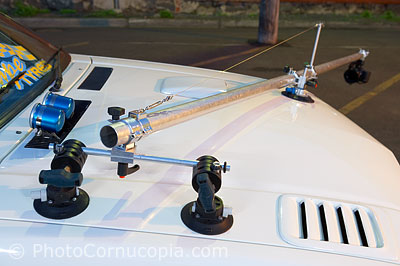 |
|
This bonnet mounted
full car rig is different to most in that there are two
vacuum cups opposite the camera and one in the centre of the boom
whilst some shooters use two vacuum cups in total. The problem with
using a single vacuum cup at the 'end of the boom opposite the
camera is that if
it does let go then the boom will fall, rotating around the centre
vacuum cup, assuming it is still holding, and possibly denting both
the panel under the cup and anything else the boom hits on it's way
down. Using 2 vacuum cups at this end gives you some redundancy so
that if one cup does let go then it is unlikely that the boom will
fall. The centre cup (centre of the boom) is not as critical as the
cups at the end of the boom. Using 2 cups opposite the camera is
about redundancy, not rigidity. If you wanted to you could add a
counter weight at this end, balancing the boom around the centre
cup, and this would prevent the boom toppling forward if the cup let
go however the added weight may be unacceptable. |
Some vacuum cups have a tendency to mark
or scuff
(lightly scratch) paint surfaces whilst others can leave a
short term imprint of themselves in the paint surface. Always make sure
vacuum cups and the surfaces they are attached to are as clean as
possible. Protect the vacuum cups with their protective pads, if
supplied, and store and transport them carefully to ensure they are not
deformed or damaged.
It's not a good idea to apply a vacuum cup
to the interior of windows which are tinted with a film as the film will
be deformed, probably permanently, by the vacuum cup. Adhesive films or
stickers on the exterior of the car should not have vacuum cups applied
because they may be damaged or deformed and they are often a cause of
air leaks causing the vacuum in the cup to weaken or let go altogether.
Vacuum cups behave differently depending
on their design and the material they are made from. Some of the effects
you might expect from a few commonly used vacuum cups are described
below.
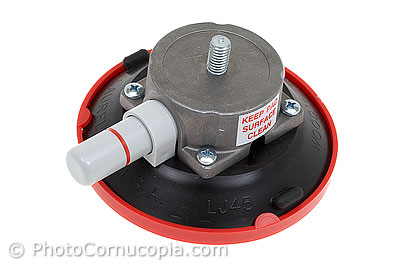 |
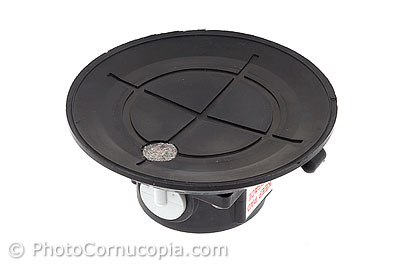 |
These cups are made
from a relatively soft rubber. They have a series of fairly deep
ridges so this vacuum cup can leave an impression of the ridges in
some paint surfaces. It seems that the 'clear' which is applied to
most paint surfaces can be quite soft, even after many years, and it
is this 'clear' which takes the impression. It is most visible with
dark colours and is often very difficult to detect with light
colours. It doesn't happen with all paints and it is very difficult
to judge when it will happen, if at all. The impression usually
disappears after a period of several hours. |
|
Woods 4.5" Suction Cup |
|
|
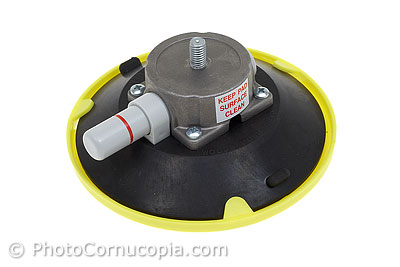 |
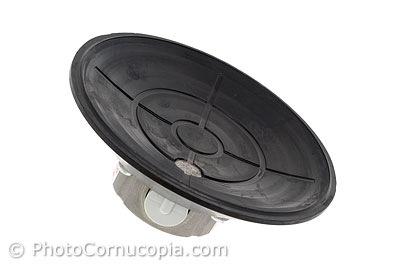 |
Same as above. |
|
Woods
6" Suction Cup |
|
|
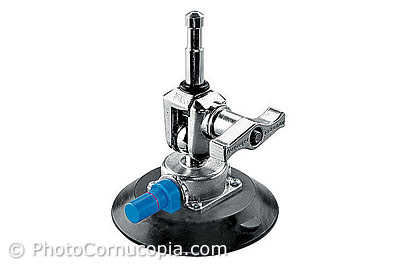 |
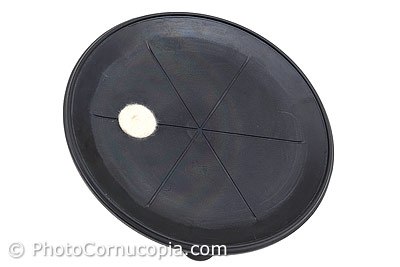 |
The Avenger/Manfrotto
vacuum cups are made from a relatively stiff rubber which can mark
or scuff (lightly scratch) paint surfaces. The cup is quite stiff so
as the vacuum increases the cup is pressed down against the paint
and this stretches the cup slightly outwards, which is when the
scuffing or marking occurs. It doesn't always happen but sometimes a
dark rubber ring, which can easily be cleaned off, is left around
the edge of the cup. Sometimes the light scuff mark may need to be
buffed out but it is generally quite minor. |
|
Avenger F1000,
Pump Cup with Swivel Pin (shown above). All Avenger/Manfrotto
Pump Cups use the same rubber pad. |
|
|
Vacuum cups simply can
not be trusted to keep their vacuum and therefore keep a rig mounted to
a car indefinitely. All vacuum cup manufactures warn users to regularly
check vacuum indicators, where fitted, and to re pump regularly. It's
safest to always assume that a rig will fall off and act accordingly, ie
keep it supported whenever possible, before, during and after the
shoot.
The simple fact is that
if you are confronted with a car where you can not afford to take any
risks then do not apply any vacuum cups to any of the paint surfaces at
all.
The above is by no means
a comprehensive list, it's just food for thought.








